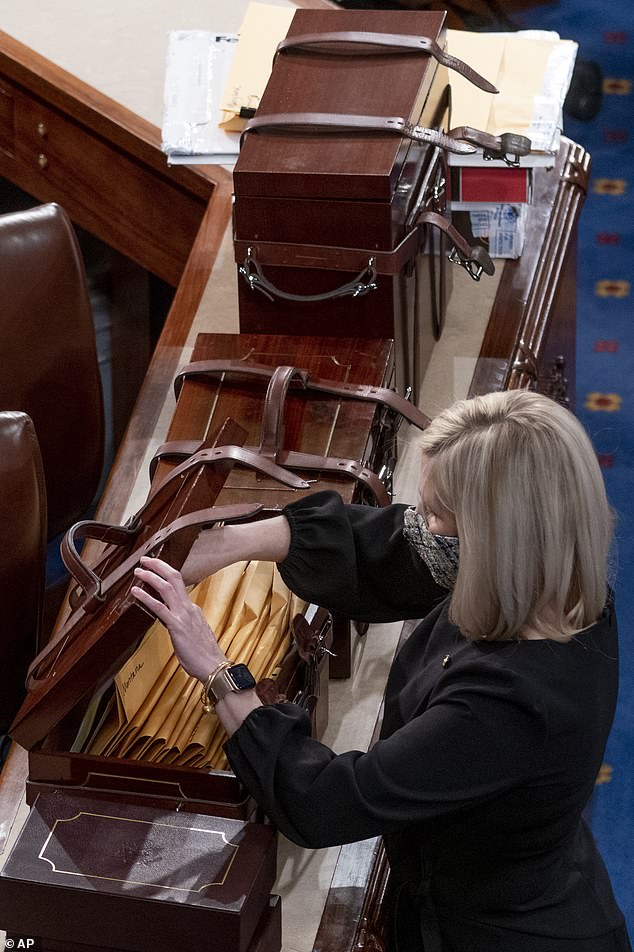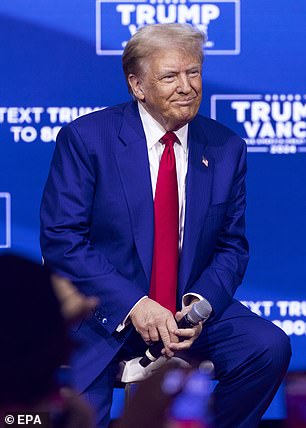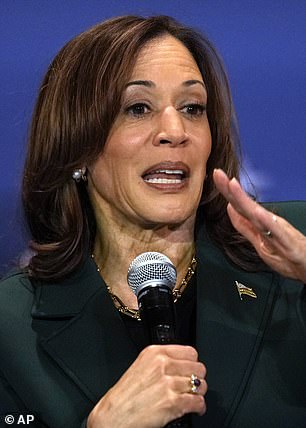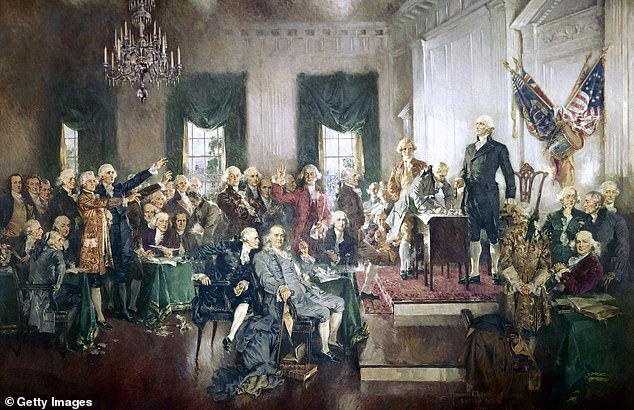How the Electoral College works – and why 270 votes will decide if Trump or Harris wins the 2024 election
When the Founding Fathers argued over how the newly formed United States would elect a president, they compromised on a unique system that became known as the Electoral College.
It requires a candidate to obtain 270 of the total 538 electoral votes. How that math works out has changed election after election, candidate after candidate.
Polls from 2024 show that most of the 538 votes have already been collected by Donald Trump or Kamala Harris – but 93 are still up for grabs in seven battleground states.
Seven states are considered swing states in the 2024 presidential race, with 93 electoral votes up for grabs, but the road to the White House will come down to who wins Pennsylvania, Georgia and North Carolina

Boxes containing the Electoral College votes from the 2020 elections are opened during a joint session of the House and Senate on January 6, 2021
The process behind the Electoral College is outlined in Article Two of the U.S. Constitution.
Each state gets as many electors as members of Congress – those in the House of Representatives and the Senate. There are currently a total of 538 electors, including three for Washington DC, which is represented despite not being a state.
Voters go to the polls on the Tuesday after the first Monday in November – which in this year’s election is November 5.
After the results, those chosen as electors will meet in the state capitals on the first Tuesday after the second Wednesday in December (which is December 17 this year) to cast their votes for the president and vice president. They then submit their votes to both houses of Congress.
Congress then certifies the results of the election during a joint session, typically held on January 6 – a date that has come into disgrace after the riot at the Capitol, when lawmakers met to certify the results of the election. To be certified in 2020.
The complex nature of the Electoral College has been controversial since its creation during the Constitutional Convention in 1787.
Proponents argue that it requires presidential candidates to have broad appeal across the country to win, while critics argue that this is not representative of the nation’s popular will.
The Electoral College was created during the Constitutional Convention after a long debate over how to elect the president.
Some Founding Fathers wanted Congress to decide and some wanted it to be a popular vote.
At the time of the Convention, no other country in the world directly elected its president, so the delegates found themselves in uncharted waters.
But some delegates worried that if Congress were to act, it would provide too much opportunity for corruption between the executive and legislative branches.
Others, however, were concerned that voters in the 18th century did not have the means to be fully informed about the candidates, especially in rural outposts.
They feared that a popular vote could lead to a charismatic megalomaniac winning over a crowd of voters and capturing the White House.
An electoral college was the compromise.
The decision also gave more power to slave states and small states.
Slave states wanted to increase their voting power (since they could count slaves as 3/5 of a person when allocating electors) and small states were guaranteed a minimum of three electors per state.
Although polls show that most voters don’t like the Electoral College, there is no easy alternative.
“I think it’s difficult to reach a consensus on what would be a better alternative,” Costas Panagopoulos, a professor at Northeastern University and an expert on the Electoral College, told DailyMail.com.
“Each of these alternatives will create biases in favor of or against certain types of places,” he noted.


Donald Trump and Kamala Harris are each trying to win the 270 electoral votes needed to become president

The signing of the Constitution of the United States, with George Washington, Benjamin Franklin and Thomas Jefferson at the Constitutional Convention of 1787; oil painting on canvas by Howard Chandler Christy, 1940. The painting measures 20 feet by 30 feet and hangs in the United States Capitol.
The Electoral College places importance on battleground states that are must-win for candidates. But switching to a popular voting system would, for example, give densely populated areas – such as New York, California and Texas – an advantage.
Moreover, it is simply difficult to change the constitution, which is necessary to introduce a new electoral system. A constitutional amendment requires a two-thirds majority in Congress, plus ratification by three-quarters of the states.
The majority of states take a winner-takes-all approach when it comes to rewarding their voters. Maine and Nebraska differ because they distribute their electoral votes to the winner of each of their congressional districts.
The campaigns of both Kamala Harris and Donald Trump have devised paths to victory, a strategy that allows states to win to give them the necessary 270 votes in the college.
There are 225 electoral votes that are considered solidly or probably Democratic, meaning they would go to Harris, while 218 would likely go to Trump.
To reach 270, Harris is keeping his eye on the three “blue wall” states — Michigan, Wisconsin and Pennsylvania — that flipped to Trump in 2016 and returned to Democrats in 2020.
If Harris wins these three states while Trump carries Nevada, Arizona, Georgia and North Carolina, Harris would win with at least 270 electoral votes to Trump’s 268.
As part of that route, Harris would need the lone electoral vote from Nebraska’s 2nd Congressional District — and she had running mate Tim Walz campaigning there this week.
The last time the blue wall didn’t vote unanimously was 1988, when Michael Dukakis won Wisconsin while losing Pennsylvania and Michigan.
Overall, the Harris campaign is focused on winning the battleground states that Biden won in 2020 — the three blue wall states, Arizona, Nevada and Georgia — plus North Carolina.
The state with the greatest chance of tipping the election is Pennsylvania.
It has 19 electoral votes, more than any other swing states, and has received most of the attention from Harris and Trump.
The Trump campaign has focused heavily on the state, which he won in 2016 but lost in 2020.
A win there plus a few more battleground states gives him victory.
For example, if Trump wins Pennsylvania, Georgia and North Carolina, that would give him 270 electoral votes.
Another path would be for Trump to win Georgia and Arizona (which he lost by a few thousand votes in 2020) and retain North Carolina. If he did, he would need just one of Wisconsin, Michigan and Pennsylvania to win.
A candidate could win without Pennsylvania, but would have to beat most other battleground states to make up for the loss of those 19 votes.
It is entirely possible to win the popular vote but lose the vote of the Electoral College. This happened in 2016, 2000 and three times in the 19th century.
Although a tie in the Electoral College is unlikely, it is possible.
If Trump wins Arizona, Georgia, Nevada and North Carolina, while Harris takes Michigan, Pennsylvania and Wisconsin but loses Nebraska’s second congressional district to Trump, the result would be a 269-269 tie.
If there is a tie, the election goes to Congress to decide.
After the 1800 election ended with Thomas Jefferson and Aaron Burr tied, the House needed 36 ballots to finally elect Jefferson president.
Lawmakers then passed the Twelfth Amendment to streamline the election process.

Protesters interrupted the certification of the Electoral College vote on January 6, 2021
On this basis, the House of Representatives, in the event of a tie, elects the president and the Senate elects the vice president. They can choose candidates from different parties to serve together in the White House.
Complicating matters further is that when elections go to Congress, each state gets one vote in the House of Representatives. And there is no required process for the state to choose who they vote for. Each state — which has Democratic and Republican legislatures — would have to decide for itself how to cast its vote.
They are not required to choose the candidate who won their state in the general election.
Moreover, the territories have no say.
“Washington DC and all the voters there will have no representation, no say in who is elected,” Panagopoulos said.
Once decided, each state’s delegation to the House of Representatives will receive a single vote, and the candidate who receives a majority of 26 of the 50 state votes will be president. In the Senate, each senator gets one vote to elect the vice president, while 51 votes are needed to determine a winner.
In 1824, Andrew Jackson won a majority of the votes, but fell short of a majority. But the runner-up in the Electoral College and the popular vote, John Quincy Adams, was able to gain enough support in the House of Representatives to win the presidency.
